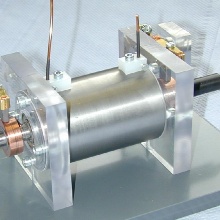Contactless capacitive energy transmission, in short, capacitive energy transmission, is a technical alternative to contactless inductive energy transmission in terms of its functional principle. In contrast to the usage of magnetically coupled windings for energy transmission as in inductive energy transmission, the electric field between several flat electrodes is used for energy transmission. In direct comparison to the more established contactless inductive energy transmission, capacitive energy transmission is less suitable for transmitting energy over large mechanical distances or for achieving high transmission capacities. There are applications for contactless transmission of low power where the advantages of capacitive energy transmission are more important than the restrictions associated with it, assuming favourable conditions for the usage of capacitive energy transmission to be at hand.
These principle-related advantages and limitations result directly from the structure of the actual capacitive transmission path specified by the functional principle.
In general, the distance between the primary-side source and the secondary-side sink or load should be very small for capacitive energy transmission. The capacity of the transmission path doubles with each halving of the distance between the two sides. Technically useful capacities for energy transfer in the range of a few watts start in the range of two-digit picofarad, which hardly allows distances of more than 1 mm for the electrodes in palm-sized areas.
In some applications; however, such a small distance is not an actual restriction. For example, if the secondary side to be supplied rests mechanically on the primary side as is the case with charger cups for mobile phones.
The advantages of capacitive energy transmission, on the other hand, would come into play in the example of the mobile phone charger. In this example, the virtually negligible thickness of the actual transmission path is a potential advantage in terms of product design. Assuming a plastic housing, the entire transmission path can be produced by two metallizations on said housing. Together with a protective layer on the outside of the device, this typically results in a total layer thickness of several 10 μm. A comparably thin inductive transmission path would hardly be technically feasible or would be significantly limited in terms of power and efficiency due to the lack of copper cross-section.
As part of the FVA 602-I research project, an application investigated in detail at the IEW addresses the capacitive power supply of sensors together with data transmission, in short, capacitive near-field telemetry. The environment in rolling bearings and gears under consideration here is often associated with thin and flat installation spaces due to its design. Here, there is no general necessity for bridging distances greater than approx. 0.5 mm. For the implementation of near-field telemetry in such test arrangements, a simple production and a high mechanical loading capacity of the actual transmission path are decisively important criteria. It is not uncommon that the transmission lines themselves are made to order for a specific test series.
Figures 1a (cover picture) and 1b show the fixed primary side and the secondary side of a capacitive transmission line mounted on a shaft, which was realized as part of the research project FVA 602-I in order to demonstrate transmission capacities in the range of single-digit watts. Additionally, the principle of good suitability for small, flat installation spaces as well as the technically simple and mechanically resistant design can be observed here.
The usage of capacitive energy transmission is obvious and technically sensible for all applications with a flat installation space and moderate requirements for transmission performance.




